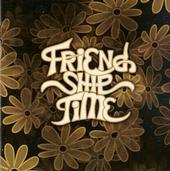------------------------------------------------------------
----------------------------
IMPORTANT
------------------------------------------------------------
----------------------------
The 10th of March will ASOKA, SOLID GROUND and FRIENDSHIP TIME perform together with BUDGIE on the ROCK AT SEA boat. Tickets costs 600 SEK but Mellotronen friends pays only 50 SEK!!! Contact [email protected] for more info.
------------------------------------------------------------
----------------------------
IMPORTANT
------------------------------------------------------------
----------------------------
From the CD booklet:
Friendship Time was founded by vocalist Enrico Adambrosi, bass player Martin Cerha and guitaris Stig Jonsson in Upplands-Vasby, a small suburban town north of Stockholm during the Autumn of 1970. The name Friendship Time was inspired by Martin's mother Marianne, who had dreamt about a group with that particular name. They were from the start in need of a drummer, and Adambrosi had heard of a talented young man who regularly practiced in the Lowgren residence nearby. His name was Thomas Lowgren, and he was soon included to complete the line-up. The Italian singer Adambrosi, on the other hand, shortly thereafter had to leave the band as the rest of the guys wanted to work on their own.
The band was now in need of another guitarist, and several auditions were held before the band finally became a quartet. The fourth member was found one day when the trio was testing new instruments at Musikborsen in Stockholm. Dag Mattsson sat on a chair beside them with a Guild guitar in his lap. Nothing was planned, but Martin and Dag immediately started to jam together. The duo hit it off quite well and from that day Dag was included as an equal member.
The band had started to rehearse at the youth club Fagelsangen in Jakobsberg, some 15 kilometers north west of central Stockholm. Many bands were at the time influenced by the rythm & blues tradition, and so was also the case with Friendship Time. One day the band was invited to the youth club's music room, where one of the youth leaders put on "The Yes Album," which recently had been released. The guys liked what they heard and Yes turned out to be their new major source of inspiration. As a consequence, the members started to develop into quite skillful instrumentalists. All but Stig Jonsson, who lagged behind and eventually had to leave the band. :(
Friendship Time at one point took part in a pop talent contest arranged by a record company. The first prize was an LP recording session. A gifted guitarist named Jan Svedestig was hired for the event. Due to his poor social capabilities, he was not a candidate for further collaboration. The band finished in second place, followed by Kent Kroon's band Index on third. Friendship Time was criticized by the record company for not being commercial enough. Kroon, on the other hand, was impressed by the band and gladly accepted to join them. With him in the line-up, there were suddenly new musical possibilities, and the band turned into an even more experimental style. Dag Mattsson had taken care of the vocals, but at this point the music parts were so complicated that they needed someone to fully focus on the singing.
Kent Kroon was acquainted to singer Leif Froling, who joined the band following an audition. The quintet then rapidly evolved into something unique on the Swedish musical scene. Sound man and producer C-G Langenskiold, who at this time worked at the Decibel studio, early on recognized the band's potential. He contacted producer Marcus Osterdahl, who also got interested. The two booked the Decibel studio and let the band record whatever they wanted under the supervision of technician Christer Berg. Marcus Osterdahl was the owner of the big Marcus Music studio in Solna, and with this in perspective it is a bit strange the band wasn't sent there instead.
Langenskiold was a friend of Richard Branson at Virgin Music in London. He was intersted in releasing the Friendship Time debut LP. THe artist Eugen Semitjob was contracted to do a painting for the LP cover. Langenskiold and Osterdahl had a few test print acetates done of what was to become their first release. When everything was set for release, the two gentlemen no longer worked together, and neither of them wanted to continue working with Friendship Time on their own. Many dreams were crushed at this moment. The cover artwork and the master tapes disappeared alongside Langeskiold. Despite that, the band untiringly continued rehearsing in their new place in Alvik Station, just outside of Stockholm.
In the summer of 1976, Leif Frolig left the band. Carrying on without him was never an option, and by that one of the most promising bands of the time left the scene for good.
Recently, the tapes were found in the home of Dag Lundqvist of Trettoariga Kriget. Upon hearing the tapes, Stefan Dimle of Paatos, Landberk and Morte Macabre worked on remastering them and finally succeeded in releasing the long lost album. Friendship Time recently reunited for the Mellotronen 20th Anniversary festival.
